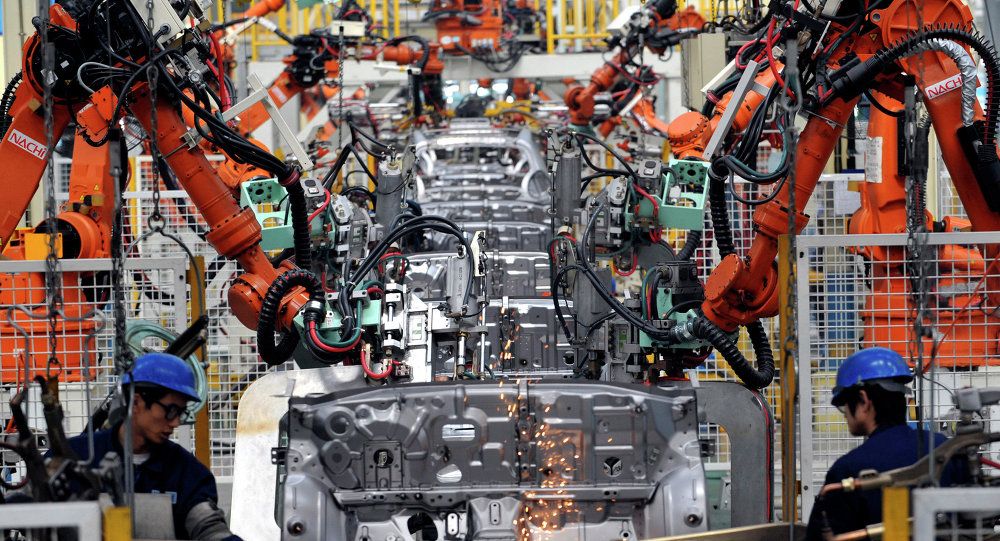Hold Them Back, Run Faster - Beating the Made in China 2025 Strategy

by JAKOB URDA, ’19
On October 4, 1957, the Soviet Union launched Sputnik, the world’s first orbital satellite. No less astounding was the R-7 Intercontinental Ballistic Missile which carried the small metal ball into space—capable of also delivering thermonuclear warheads to American cities. In launching the space race, Sputnik ushered in the age of the ICBM. Whoever mastered rocket technology would be able to project their power overseas, ensure the safety of their people from direct military action, and cudgel adversaries with the promise of total annihilation. Geography’s restrictions on influence would melt away, opening new doors to Soviet power in Africa, South Asia, and the Americas. Such force would forever alter the global balance of power, making the devastation of the US homeland possible for the first time in history. Americans watched with dread as their sworn adversary monopolized space technology, a field which would define the next four decades of geopolitics. In a single day, the Soviet Union confidently took the lead in the space race, and converted its technological edge in rockets into strategic political and military superiority.
Of course, the Cold War did not end with Soviet rocket technology translating into a century of international communist domination. Eisenhower and later presidents understood that the USSR’s advantage in space was a matter of national security rather than of exploration, and therefore demanded uncompromising attention. The United States responded aggressively, funding space research and working with allies to invest in emerging technologies. In one of our finest hours, we founded DARPA and NASA, and tasked them to build a network of academic and industrial partners in order to close the gap between American and Soviet research. Aside from achieving parity in missile technology, these efforts cemented American leadership in a number of crucial emerging sectors, from GPS to computer science. The comparative advantage that America and its allies developed by investing in and eventually dominating these fields would ensure their economies and militaries would overshadow the USSR’s for the remainder of the Cold War.
Last week, President Trump announced new tariffs on 200 billion dollars of Chinese goods ranging from seafood to industrial equipment. The administration partially justified their tariffs based on China’s “Made in China 2025” initiative— Beijing’s strategic plan to dominate 10 key industries such as robotics, aerospace industry, and biopharmaceuticals. “Made in China 2025” poses legitimate concerns to our federal government. China uses industrial espionage and illiberal trade practices to coerce American firms in to giving up patents, costing US firms billions of dollars. The Chinese Communist Party (CCP) also employs state resources to make Chinese technology giants immune from prosecution, prop them up with anti-competitive subsidies, and funnel stolen technology into Chinese hands. Examples include Huawei and ZTE, which the FBI censured for their links to the Chinese government and concerns about technology stealing.
How should we think about “Made in China 2025” and how should we respond? The Cold War sheds light on the modern great power contest with China. The story of America’s struggle to remain competitive against Soviet technology suggests two things: 1) That “Made in China 2025” is a significant threat to the future of American leadership, and 2) that tariffs will not stop it.
In order to fully understand the current situation, we must consider why technology has historically been so important for US strategy. American dominance over cutting-edge science bolstered our deterrence against the USSR, provided the economic growth needed to make our allies feel secure, and exposed the flaws of central planning. Beyond the 1950s, the technology-first approach to American grand-strategy has been supported by established doctrine. In 1983, the Defense Intelligence Agency published a report under the program ‘Project Socrates’ to understand how to ensure the endurance of American power. They wrote: “The exploitation of technology is the most effective foundation for decision making for the complete set of functions within the private and public sectors that determine U.S. competitiveness.” The United States is not the world’s most populous nation, nor the richest in every natural resource—the fundamental source of strength of American economic strength is our qualitative edge in research. With the erosion of our productivity by technologically superior rival powers, America cannot realistically maintain its global influence and leadership.
China’s push to dominate emerging technology is every bit as important as the scientific revolutions of the 20th century. The Council on Foreign Relations called the “Made in China 2025” program an “existential threat to US technological leadership.” If China were the first to roll out 5G infrastructure, for instance, it could force tech creators to go to China to develop and pilot new inventions. 5G is a necessary component in artificial intelligence, mass data gathering, and internet-of-things technologies. Just as American advantages in 4G infrastructure allowed Facebook and Google to become the world’s leaders for social media and the internet, next-generation technologies may be dominated by Huawei and ZTE. These emerging technologies have the potential to be just as transformative as the atom bomb—AI could revolutionize commerce and surveillance, while gene-editing could have profound social and military implications.
Not only could a scientifically dominant China be in a position to coerce us by restricting trade, it would set the norms and standards for new technology. There is reason to believe that the norms set by the CCP would be significantly more illiberal than those set by Washington. The United States—while hardly perfect—encourages political reform within autocracies, understands that sovereignty does not offer unlimited protection against human rights abuses, and actively cultivates a system of international trade based on economic openness and individual freedom. When leading the rollout of the internet, America established widely held standards for user-freedom. China’s attitude towards global norms is noticeably more autocratic: supporting Sudan’s military in the Darfur genocide to access Sudan’s natural resources, selling mass surveillance technology to Ecuador, and threatening to cut off access to the Chinese market for businesses who do not censor their content or provide them with data. Beijing’s leadership encourages the naked exploitation of smaller states by larger ones, such as in the Hambantota port scandal, where China used coercive loans to seize strategic naval infrastructure from Sri Lanka. At the same time, China holds the liberties of the individual in far lower esteem than America, operating the world’s largest surveillance state against its Uyghur Muslim minority and actively empowering its allies in Pakistan and North Korea to do the same. Whatever the flaws of American leadership, Chinese domination of next-generation AI, pharmaceuticals, and natural resources would be far worse. The implications of Beijing reshaping global norms in its own image would be a dramatic curtailing of the international respect for freedom.
While the Cold War taught us the invaluable advantage conferred from research and science, it also suggested that an economic approach is insufficient to deter China’s ambition. The space race was never just about exploration – it was the crux of America’s grand strategy to pursue scientific superiority. Today, China sees the “Made in China 2025” program the same way— modern technology defines competitiveness. The question is not merely economic but strategic, with implications for the next hundred years of Chinese leadership and geopolitics. President Trump’s latest round of tariffs will sting, no doubt, but it is hard to envision anything more than a facial compromise from CCP leadership. Much like the space race was far more important than reaching the moon, “Made in China 2025” is far more important than short-term economic growth. American trade comprises roughly 18 percent of Chinese exports. While this is hardly insignificant, China cannot view economic issues with the same gravity as its grand-strategy. Economic problems call for economic responses, but strategic challenges demand strategic solutions.
In a recent congressional hearing concerning Chinese technology theft, William Alan Reinsch from the Center for Strategic and International Studies said, “We have two strategies: we can hold China back, and we can run faster.” That is to say, America needs to crack down on technology stealing while redoubling our own investments in research. In terms of restricting China’s acquisition of new technology, an aggressive retrenchment of liberal trading rules and strengthening intellectual property protections is needed. Free trade among allies in Asia and Europe (through programs such as the Trans Pacific Partnership, or a free trade deal with the EU) would create a uniform set of standards consistent with liberal norms which China would be forced to comply with when trading. While Huawei can threaten American companies into surrendering technology when we stand alone, it would think twice if doing so shut it out of the world’s markets. Organizing in blocs would give liberal nations far more bargaining power to demand an end to technology stealing and strengthen the competitiveness of Western business.
Defeating China’s bid to dominate emerging technology also requires increasing our own research faculties. We can start by expanding tax credits for research and development and subsidizing multilateral scientific projects with our allies to keep America ahead of Chinese development. Beijing pours billions of dollars into emerging technology, and we have the resources to match that. Like during the Cold War, one of the greatest strengths of liberal democracy is that our free and independent institutions have made us exceptional innovators. No matter how much the Trump administration admonishes China, beating the CCP in the race to dominate cutting-edge research will require aggressive investments in Western institutions—from university labs to international research groups like CERN.
The technological rise of China poses a dramatic challenge to America’s global leadership. But history tells us that it is a challenge that we can meet.





